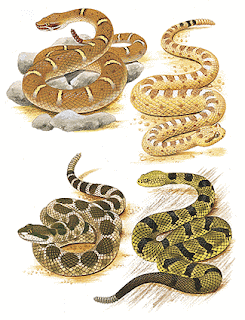Science Fact of the Week 53 - Rattlesnakes by Hannah Wentges
Rattlesnakes are a group of venomous snakes containing approximately thirty species with numerous subspecies. They get their name form the rattle located at the end of their tails which is used as a warning sign when the snake is threatened. Rattlesnakes eat mice, rats, small birds and other small animals. They subdue their prey quickly with a venomous bite instead of constricting them. The venom immediately stuns or kills their prey.
Most rattlesnakes mate in the spring and all species give birth to live young instead of laying eggs. The young are self-sufficient from birth and since they do not need their mother then, she does not stay with them for long. The rattle is made up of a series of nested, hollow beads which are actually modified scales from the tail tip. Each time the snake sheds its skin, a new rattle segment is added. They can shed their skins several times a year depending on food supply and growth rates. Newborn rattlesnakes do not have functional rattles; it is not until after they have shed their skin for the first time that they gain an additional bead, which beats against the first bead, known as the button, to create the rattling sound.
Rattlesnakes are born with fully functioning fangs capable of injecting venom and can regulate the amount of venom they inject when biting. Generally they deliver a full dose of venom to their prey, but may deliver less venom or none at all when biting defensively. A frightened or injured snake may not have such control. Young snakes are also dangerous, because their venom is actually more potent than that of the adults.


Comments